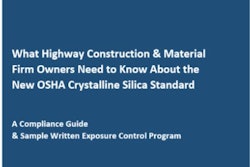Just coming off the one-year anniversary of my father’s passing from “farmer’s lung”, it’s not surprising that the first thing that came to mind as I sat down to write this column is the risks of occupational illness. As a lifelong agriculturalist, my father faced work site challenges that should sound familiar: the rigors of heavy physical labor; daily exposure to the elements; operation of large equipment in a range of tough conditions; the need to handle harsh chemicals and compounds; ongoing exposure to dust, dirt and debris, etc. Any of these scenarios has a potential to become hazardous if proper safety precautions aren’t taken. In my father’s case, the culprit proved to be the smallest of them all. Inhalation of fine dust particles from plant products (grain and hay) produced a reaction that over time damaged his lungs to such a point that one doctor compared them to those of a long-term heavy smoker (which my father was not). After years of dependence on medications, inhalers and supplemental oxygen, as well as several long-term hospitalizations, his lungs gave out, but not before much physical suffering on his part and emotional and financial suffering on the part of my family.
It’s unfortunate that in my father’s generation there was little awareness and education on the hazards of various forms of dust inhalation. But even as information emerged, many from that era, already set in their ways, were unlikely to use PPE without strong outside encouragement. Because the repercussions were not immediately felt, they were easy to ignore. Their cumulative impact was only felt years later.
A similar situation can manifest from another common hazard for outdoor workers: sun exposure. Frequent, prolonged and unprotected exposure to the sun’s UV rays can produce damaging effects to the skin, including skin cancers. According to the Center for Disease Control, nearly 5 million people in the U.S. are treated for skin cancer each year at an estimated annual cost of $8.1 billion. Productivity is severely affected. And in some states, employers may be required to provide workers’ compensation to employees who get skin cancer due to on the job sun exposure. (Learn more at www.cdc.gov/cancer/skin/pdf/skincancer_employees.pdf.)
My point is to draw attention to certain hazards that may get forgotten in the scope of larger safety concerns and tight project timelines. OSHA makes it the employer’s responsibility to take steps to mitigate the hazards workers face on their jobsites. But how many workers either still don’t have access to or don’t use appropriate PPE and dust mitigation processes during concrete cutting — even given the recently tightened silica exposure limits? (I came across yet another example just last week.) And how many construction firms either don’t have policies in place, or fail to enforce policies, regarding protection against excess sun exposure on their sites?
Some hazards may appear more innocuous than others, and some may not be directly mandated by OSHA regulation. But when it comes to the potential impact on quality and quantity of life, they can be just as worthy of your consideration. For the sake of your workers and their families — whether now or in the future — promote best practices to mitigate safety risks of all types, regardless of the form, or size, they may take.



















